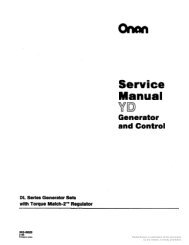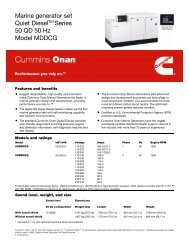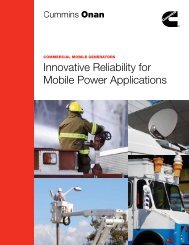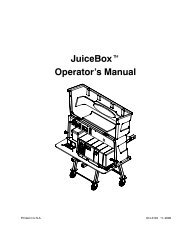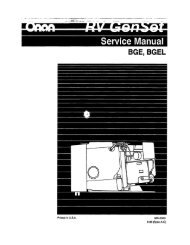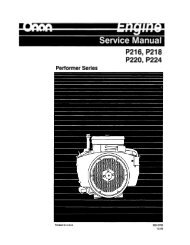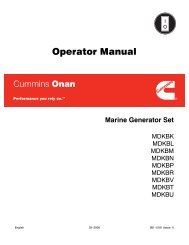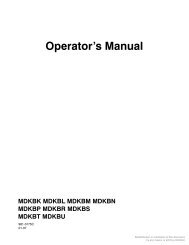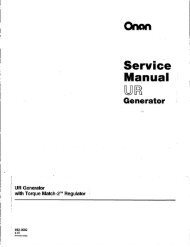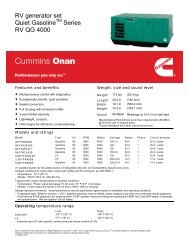Caution: This document contains mixed page sizes ... - Cummins Onan
Caution: This document contains mixed page sizes ... - Cummins Onan
Caution: This document contains mixed page sizes ... - Cummins Onan
Create successful ePaper yourself
Turn your PDF publications into a flip-book with our unique Google optimized e-Paper software.
4. Preparations for Service<br />
SPECIAL TOOLS<br />
The following tools are necessary for servicing the<br />
genset:<br />
Torque wrench: 0-75 lbs-ft (0-100 N-m)<br />
Tachometer<br />
Digital multi-meter: AC and DC Voltage, Ohms<br />
Load test panel and leads<br />
SAFETY<br />
Hazards and Their Sources<br />
There are hazards in servicing gensets. Study Safety<br />
Precautions and become familiar with the hazards<br />
listed in Table 4-1. Note the following safeguards<br />
and ways of avoiding hazards:<br />
• Use personal protection: Wear appropriate<br />
protective safety equipment, such as safety<br />
shoes and safety glasses.<br />
Do not wear rings or jewelry and do not wear<br />
loose or damp clothing that might get caught<br />
in equipment or conduct electricity.<br />
• Reduce the hazard: A safe, orderly workshop<br />
area and well-maintained equipment reduce<br />
the hazard potential. Keep guards and shields<br />
in place on machinery and maintain equipment<br />
in good working condition. Store flammable liquids<br />
in approved containers; away from fire,<br />
flame, spark, pilot light, switches, arc-producing<br />
equipment and other ignition sources. Keep<br />
the workshop clean and well-lighted and provide<br />
adequate ventilation.<br />
• Develop safe work habits: Unsafe actions<br />
cause accidents with tools and machines. Be<br />
familiar with the equipment and know how to<br />
use it safely. Use the correct tool for the job and<br />
check its condition before starting. Comply with<br />
the warnings in this manual and take special<br />
precautions when working around electrical<br />
equipment. Do not work alone if possible and<br />
take no risks.<br />
• Be prepared for an accident: Keep fire extinguishers<br />
and safety equipment nearby. Agencies<br />
such as the Red Cross and public safety<br />
departments offer courses in first aid, CPR and<br />
fire control. Take advantage of this information<br />
to be ready to respond to an accident. Learn to<br />
be safety-conscious and make safety procedures<br />
part of the work routine.<br />
TABLE 4-1. HAZARDS AND THEIR SOURCES<br />
Fire and<br />
Explosion<br />
Burns<br />
Poisonous<br />
Gas<br />
Electrical Shock<br />
(AC)<br />
Rotating<br />
Machinery<br />
Slippery<br />
Surfaces<br />
Heavy<br />
Objects<br />
• Leaking or spilled fuel<br />
• Hydrogen gas from battery<br />
• Oily rags improperly stored<br />
• Flammable liquids improperly<br />
stored<br />
• Hot exhaust pipes<br />
• Hot engine and generator surfaces<br />
• Electrical shorts<br />
• Operating genset where exhaust<br />
gases can accumulate<br />
• Improper generator connections<br />
• Faulty wiring<br />
• Working in damp conditions<br />
• Jewelry touching electrical<br />
components<br />
• Fan or belt guards not in place<br />
• Leaking or spilled oil<br />
• Removing genset from vehicle<br />
• Removing heavy components<br />
Testing the Genset Inside a Building<br />
Make sure there is ample fresh air when operating<br />
the genset inside a building to prevent carbon monoxide<br />
asphyxiation.<br />
WARNING EXHAUST GAS IS DEADLY! Engine<br />
exhaust must be vented outside if the genset is<br />
operated inside a building.<br />
4-1



